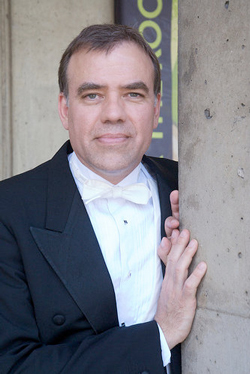by Daniel Hathaway
Twenty
Music Director Christopher Wilkins was the warm, chatty and versatile emcee for the evening, which began with tributes to volunteer leaders Ann Lane Gates, Brenda L. Justice and Angeleina Valentine. Then Wilkins launched into a rousing performance of There is No Way by Brunson/Cady with soloist Doretha Folds-Williams that gave the white-clad, golden-stoled choir led by Jennifer Mekel Jones their first opportunity to fill the hall with full-throated singing. All in His Hands (Hayes/Massey) followed, featuring a striking stop-time ending.
The two-and-a-half hour program continued with a mix of music drawn from the last two decades of GMS programs as well as more recently composed songs and arrangements.
Principal clarinetist Kristine Belisle Jones brilliantly reprised a movement (“Calypso”) from David Baker’s Three Ethnic Dances recorded for Telarc in 1994 with Balter on the solo part — a project that originally helped spawn Gospel Meets Symphony.
Akron-based baritone Brian Keith Johnson sounded splendid in Lee Hoiby’s setting of selections from Martin Luther King Jr.’s I Have a Dream speech, which was delivered fifty years ago this summer. Johnson’s diction was so perfect that every word came across vividly in the house.
Divine Hope, with long-time GMS musician Chuck Myricks, Leslie Parker-Barnes, Carla Davis, pianist Bernadette Salley and drummer Christopher Davis, were featured in Myrick’s original composition, Victory, as arranged by Eric Benjamin. Another GMS tradition, the talented LeGrair brothers (Durell, Emmanuel and Jaron) closed the first half with energetic singing and dancing in McLemore’s Been So Good, arranged by ASO violinist David Kempers.
A long line of young singers from YEPAW (the Youth Excellence Performing Arts Workshop) marched on with the precision of a drill team to open the second half and captivated the crowd with Whitfield’s call and response Genesis, led by Leslie Parker Barnes. Praise dancers from Divine Inspiration were featured in Richard Smallwood’s Anthem of Praise (arranged by Kempers).
Then for something completely different, the GMS choir and orchestra welcomed back former Akron Symphony assistant conductor Eric Benjamin for excerpts (“only the best parts,” Wilkins quipped) from the choral finale to Beethoven’s Ninth Symphony. Angeleina Valentine, Wanda Culp-Lias, Michael Farmer and Blair Lias formed the solo quartet, and for the first and last time during the evening, the chorus sang from scores.
Smallwood’s Total Praise, arranged by Bernadette Salley with the chorus led by Cleo Myricks, Lewis’s Pass Me Not (featuring pianist Ralston Purkiss) and Fortune’s I believe (featuring three ministers in dramatic speaking and singing roles) ended the formal program on a devotional note, with a strongly hinted-at encore, Keep it Moving, ready and waiting in the wings (yes, they did it to close the show).
The 2013 Gospel Meets Symphony Choir was well-prepared by Jennifer Mekel Jones, who took on the daunting task of pulling singers from more than 70 churches into a cohesive ensemble. Predominately made up of female voices, the choir was at its strongest in unison passages and less-complex textures, making up in enthusiasm any vocal power it seemed to lack in the Beethoven. The Akron Symphony sounded excellent in the “Ninth” and, spurred on by the indefatigable Wilkins (who danced offstage to end the first half) fully got into the spirit of all the extra-classical styles on the program.
One important element — sound reinforcement — was problematic all evening. Amplification sometimes favored the chorus and rhythm section over the orchestra’s strings (you could see them playing but couldn’t hear them), sometimes solo levels became deafening (the LeGrair Brothers’ number at the end of the first half), and sometimes important solos were nearly inaudible (Ralston Purkiss’s piano solo was a distant tinkle and the sound of the Hammond B-3 — such an important voice in gospel music — went completely missing). The stand mics for the Beethoven soloists were ineffective.
Though a better sound design would vastly have improved balances, the high-energy levels of the evening came through loud and clear and the audience whooped and shrieked its approval at the end. Happy Twentieth, GMS, and long may you wave!
Click here to comment on this article. All comments will be moderated by the editorial staff.
Published on ClevelandClassical.com February 27, 2013
Click here for a printable version of this article.


